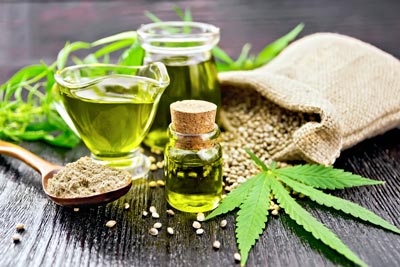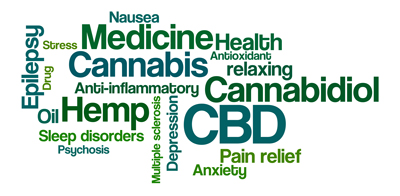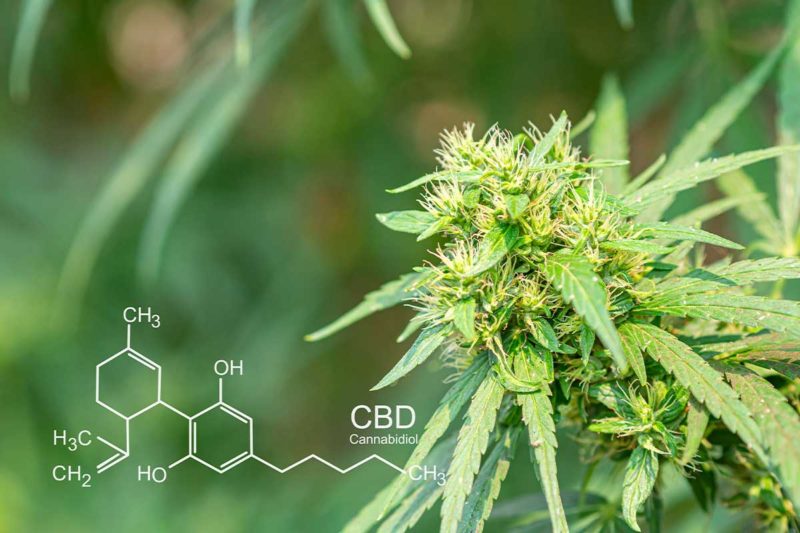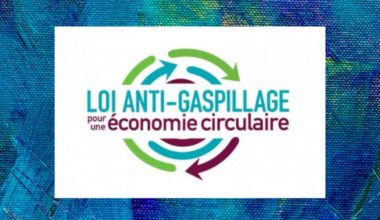Cannabidiol, one of the non-psychotropic molecules derived from hemp, is going down a storm due to its multiple benefits in terms of wellness, which range from relaxation to recovery for sportspeople and relief of chronic pain. We get the lowdown on the star molecule of the moment.
It’s everywhere now. There’s no longer a single neighbourhood or town without a specialist CBD shop or shops. There are masses of online stores, and brands thrive all year round. Even the wellness aisle in French high-street mainstay Monoprix offers oils and dietary supplements based on CBD. Because this molecule is now available in all its forms: cigarettes, vaping liquids, edible or massage oils, dietary supplements, beauty products, teas, infusions, canned drinks, cakes, honey and chocolate. CBD has also made it into food. Famous pastry chef Philippe Conticini has included it in one of his desserts, baker Anthony Courteille has made a chocolate bar out of it, Will’s Deli has included it in its Pastraweed sandwich, and baristas are mixing cocktails and virgin cocktails with CBD. So has CBD just been hyped up by Bohemian yoga devotees, or is it a bona fide therapeutic molecule?
The history of CBD in a nutshell

In the beginning there was hemp
Hemp, or cannabis sativa (Latin for cultivated hemp), is a herbaceous flowering plant in the Cannabaceae family. This plant native to equatorial regions has been bred to suit all regions of the world. Hemp is cultivated for its strong fibres and highly-nutritious grains, and has been used by mankind since 8000 B.C. The earliest documented use of medication derived from cannabis dates back to 2737 B.C., when Emperor Sheng Nung of China used tea infused with cannabis to relieve not least malaria, memory loss, rheumatism and gout. In the 19th century, Queen Victoria is said to have used cannabis to relieve her menstrual cramping. But at the time, the plant was used wholesale without its various components being separated out.
The fundamental difference between CBD and THC
In 1839, Irish doctor and researcher William B. O’Shaughnessy was the first to publish a study on the therapeutic effects of the plant, particularly as an anaesthetic.
In the early 1930s, British chemist Robert S. Cahn was the first to discover an isolated cannabinoid, reporting on the partial structure of cannabinol.
In 1940, American chemist Roger Adams was the first to extract cannabidiol (CBD). His research is also behind the discovery of tetrahydrocannabinol (THC), that psychotropic molecule in cannabis which makes it addictive.
But it was really in the 1960s that another researcher, Raphael Mechoulam, an Israeli biochemist at the Hebrew University of Jerusalem, identified the molecular structures of THC and CBD. He worked out that while the former is psychotropic, CBD is not a toxic psychoactive substance. After having discovered CBD, Mechoulam and his colleagues ran tests on various subjects, not least primates, which showed that CBD was not the molecule that caused the sedatives and intoxicating effects of cannabis. This research revealed that this molecule probably had therapeutic effects. From that point on, interest in CBD and its potential medicinal use soared.
Recognised as an antiepileptic

In the 1970s, lots of research was done. It was demonstrated, not least, that CBD could be an anxiolytic, and also an effective nausea and sleep disorder remedy. Though this research did not really lead to recognised scientific studies, it provided proof of a therapeutic application. In 1973, a team of Brazilian researchers announced that CBD could remedy epilepsy effectively. But it was not until 2013 that a documentary on American channel CNN shone a light on CBD. It told the story of Charlotte Figi, a little girl from Colorado with Dravet syndrome (a very rare form of chronic epilepsy). In the absence of an effective treatment and faced with the hundreds of seizures that she had each week, her parents sought out an alternative solution: cannabis oil particularly high in CBD. After that, Charlotte only had 2 to 3 seizures per month. This remedy for childhood epilepsy went on to be the only pharmacological treatment to secure clearance from the FDA (Food and Drug Administration).
Photo ©Yummy weed
Gaining traction in the USA
Back in 1996, California became the first state to pass Proposition 215 legalising cannabis for medical use. It was followed by 7 other states (Oregon, Alaska, Washington, Maine, Hawaii, Nevada and Colorado). This legalisation of cannabis for medical use enabled researchers to extend their studies to medical use. CBD and its potential to address ailments such as anxiety, depression, insomnia, arthritis, fibromyalgia, chronic pain, epilepsy and a great many neurodegenerative diseases. In the years following the media attention on CBD and cannabis, there was a radical shift away from their stigmatisation in the USA, not least due to the opiate crisis in the USA and Europe. This led to renewed interest in CBD. Faced with the magnitude of this problem and the addiction and harm caused by taking opiates, researchers worked on alternative solutions to bring relief for those suffering chronic pain.
Through to its arrival in France
CBD crossed Europe and, subject to unpredictable regulatory changes there, found a safe haven where it could develop freely in Switzerland. Because the country allows the use of hemp containing up to 1% THC, and is not restricted to the EU catalogue of hemp varieties. Local growers needed no further prompting to start cultivating hemp high in CBD, with crossbred European-American varieties. The development of CBD flower cultivation in Switzerland then spread to Italy, Belgium and Luxemburg, where regulations were revised to allow the trade in CBD flowers. But few changes were made to France’s legal framework.
What does French law say?
CBD recognised by the WHO and the EU
In an official report dated 2017, the World Health Organisation (WHO) stated that CBD was not harmful to human health, and was not psychoactive or addictive. The WHO advocated further research into the therapeutic properties of CBD to better scope out its potential. In the so-called “Kanavape” ruling of 19 November 2020, the European Court of Justice also ruled that CBD did not constitute a narcotic and was allowed free movement in the European Union.
Very tightly controlled in France
However, in France, Article 1 of the Order of 22 August 1990 on narcotics limits hemp cultivation, import, industrial and commercial use to the plant’s fibres and seeds. This means that it prohibits the import and sale of any product containing cannabidiol (CBD) oil yielded from whole hemp plants, and particularly the leaves and flowers, which naturally contain CBD.
As regards this Order, the Appeal Court of Aix en Provence referred an application for a preliminary ruling to the European Court of Justice (ECJ). It pertained to the consistency of the Article of 1990 with European Union laws. The ECJ ruled that a national measure which prohibits the sale of CBD from the whole plant constitutes an impediment to free movement.
Moreover, bear in mind that products containing CBD are still subject to the provisions of French law, and particularly the following:
They may not make claims of therapeutic benefits, unless they are authorised for medicinal use by the French Drug and Health Product Safety Agency, or the European Commission, on the basis of an application assessed against scientific quality, safety and efficacy criteria. Any breach of the above carries criminal sanctions. (source: www.drugs.gouv.fr/actualites/cannabidiol-cbd-point-legislation).
While officially the French authorities have acknowledged this ruling, they have also reiterated “their warnings concerning the potentially harmful effects of the CBD molecule, about which little is known at the present time”.
For the moment, in France, to be cleared for use, CBD must be from a cannabis sativa L. variety cleared under the regulations, and the products must come from a plant whose THC content is below 0.2%. Their THC content must be certified by a specialised, independent laboratory.
Mechanism and benefits of CBD
The body produces its own cannabinoids, which are responsible for balancing the immune system
The human body produces its own cannabinoids with specific receptors, the endocannabinoid system. Discovered in the early 1990s, it’s responsible for homeostasis (overall balance). Endocannabinoids are essential to proper nervous system function, and influence a great many physiological processes (mood, memory, digestion, motor function, immune response, appetite, pain, blood pressure and bone growth) and help coordinate messages between body and brain.
The two main receptors in the endocannabinoid system are the CB1 receptors (located in the brain, liver, kidneys, lungs and central nervous system) and the CB2 receptors (in the immune system and peripheral organs). While THC hits these receptors directly, CBD takes a subtler, less direct approach. Instead of attaching itself onto these receptors, CBD affects the way in which these receptors send signals and their chemical components to the body. CBD also increases the production of endocannabinoids, including anandamide, which affects mood and memory.
As well as its indirect effects on endocannabinoid receptors, CBD influences other receptors in the brain and body, including opiate receptors (pain sensation regulation) and serotonin receptors (mood regulation).
The benefits of CBD

CBD has “inside and outside” properties, i.e. both when ingested and when applied to the skin, which vary and are ramped up according to its concentration (5%, 10% or 20%). It optimises the natural response of the nervous system, by acting as a painkiller and anti-inflammatory. It does not treat ailments, since it does not take away their symptoms, but it reduces their impact by sending signals which essentially tell the body not to worry about them.
CBD is recognised as having a relaxing effect: it reduces stress, anguish and anxiety and remedies sleep disorders.
- It stimulates memory, concentration and mental acuity.
- It mitigates pain, not least that caused by certain chronic diseases (multiple sclerosis, fibromyalgia, etc.).
- It helps combat inflammation and chronic inflammatory syndromes (arthritis, irritable bowel syndrome, Crohn’s disease, endometriosis, etc.), and also painful periods when applied to the affected area.
- It has effects on certain neurological conditions, in particulier epilepsy, and disorders neurodegenerative disorders, such as Alzheimer’s and Parkinson’s disease.
- It is also used as an adjuvant to heavy-duty treatments for some types of cancer.
- When applied as a beauty product, it is claimed that it has anti-inflammatory, antioxidant, regenerative and antimicrobial proprieties. It therefore has anti-ageing proprieties and also helps skin prone to blemishes, acne and eczema.
- Its relaxing and anti-inflammatory properties also improve post-exercise recovery and prevent cramping, aches and muscle spasms after exertion.
- It is even said to reduce addiction to cigarettes, drugs and alcohol, by modulating the reward effect of the addictive substances.
What you should know before making your choice
What is the entourage effect?
CBD oils are often labelled as containing broad-spectrum or full-spectrum CBD extract. The latter comes from full extraction of the hemp plant whereby all the parts are used (flowers, leaves, seeds and stalks). And there are more than 140 active molecules in hemp.
As well as CBD, it contains other cannabinoids. These include cannabidiolic acid (CBDa), cannabigerol (CBG), cannabichromene (CBC) and cannabinol (CBN) – and also esters, terpenes, fatty acids from hemp seeds, vitamins E, A, B1, B2 and B6. Together, these components act in synergy, which lends them greater efficacy than CBD has on its own. This is known as the entourage effect. But full-spectrum extracts contain a small percentage of THC (<0.2%). Watch out when buying products from other countries. In Switzerland for example – where extraction often takes place – up to 1% THC is allowed.
Broad-spectrum extracts are produced in the same way, but with an additional step, chromatography, which is used to remove the THC from the mixture.
The extraction method
There are several methods of extracting CBD from hemp: extraction by hand, using water, with or without solvents, using supercritical CO2, ethanol or isopropyl alcohol. Each method has its advantages and drawbacks, but extraction using CO2 is a surefire way of yielding a high-purity product without chemical residues.
Dosage
A product containing 5% CBD contains 95% hemp oil and 5% CBD. There are concentrations of 5%, 10%, 15% and even in excess of 20%. There is no precise dosage, but recommendations which vary depending on the symptoms being addressed. It is recommended to adjust your CBD intake depending on your weight, starting with 5% and increasing it gradually until the dose meets your needs.
CBD often comes in oil format because cannabinoids are fat-soluble. So CBD oil can also be reconstituted”, i.e. by taking any edible oil (coconut, grapeseed or plum stone) and adding CBD isolate. Some brands combine CBD with adaptogenic plant extracts – either energising or relaxing depending on the desired effect.
Use
CBD oil is mainly taken sublingually (via a few drops placed under the tongue). This is so that it passes easily into the blood vessels in the mouth and under the tongue. You then have to wait at least one minute before swallowing. The effects will start to make themselves felt after 15-30 minutes, and peak around an hour and a half after ingestion.
When CBD is ingested in the form of a dietary supplement, it goes through the intestines which makes this the most effective format against intestinal inflammation. It then gets sent to the liver. You will start to feel the effects after around 1 hour on an empty stomach, or up to 3 hours if you have eaten.
Topical formats can be used for skin, muscle or joint complaints, and do not enter the bloodstream. The presence of terpenes appears to increase absorption into the skin.
Potential drug interactions
Studies to identify potential interactions between CBD and specific medications are still ongoing. However, there’s an empirical rule that can help consumers: avoid CBD if you are on any treatment whereby you have been advised against consuming grapefruit. Because around half of the medications metabolised are metabolised via an enzyme, CYP3A4, with which both grapefruit and CBD interfere. According to the FDA (American Food and Drug Administration), the consumption of grapefruit with some medications can lead to a higher concentration of the medications in the bloodstream and unwanted side effects, or even an overdose. If in doubt, ask a doctor or stick with topical use.
So is CBD use a passing fad? Probably not. Because while its use can seem trivial or even fun, going by the messaging in some cases, it offers real benefits reported on by regular users. And scientific studies into it are only just beginning. Countries where it is in therapeutic use, like Canada and Israel, are carrying out lots of research. This included research into CBD as an adjuvant to COVID-19 treatments.







